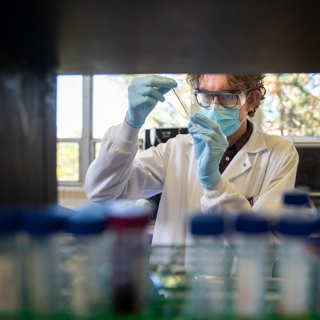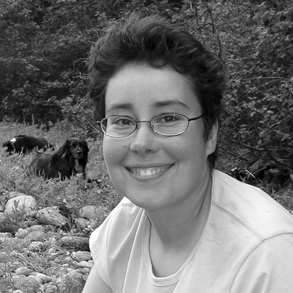People
Hélène Bazin-lee
Research Professor
Contact
- Office
- Health Science Building - HS 409A
- helene.bazin-lee@mso.umt.edu
- Office Hours
7am-4pm
Personal Summary
After completing a M.Sc. in Chemical Engineering at the ENSCCF (Clermont-Ferrand's Superior National School of Chemistry, France) with an emphasis in organic chemistry, Hélène received a Ph.D. in Organic Chemistry from the University of Lyon I (France) in 1994. During her postdoctorate at the University of Iowa under Professor Robert Linhardt, she developed synthetic methods for the synthesis of glycosaminoglycan building blocks and other sulfated carbohydrates. After working in industrial R&D involving carbohydrate modifications, she joined Corixa (acquired by GlaxoSmithKline in 2005) in Hamilton (MT) in 2002 and worked on developing new TLR agonists as vaccine adjuvants. Dr Bazin-Lee left GSK in 2016 and joined the department of Biomedical and Pharmaceutical Sciences at the University of Montana in Missoula. Her current research interests include the design and synthesis of TLR agonists and antagonists as therapeutic immunomodulators, targeted delivery and drug conjugation.
Education
M.S.: ENSCCF (Clermont-Ferrand's Superior National School of Chemistry, France), Chemical Engineering, 1991
Ph.D.: (summa cum laude) - University Claude Bernard - LYON I (France), Organic Chemsitry, 1994
Post-Doctoral Associate - College of Pharmacy, Medicinal and Natural Products Chemistry, University of Iowa, 1995-1999
Research Interests
The research focus of our group is the design, synthesis and development of new and safe vaccine adjuvants.
Vaccines have played a key role in the reduction of morbidity and mortality caused by infectious diseases since their introduction over 200 years ago. Many of the safest and most effective vaccines in use today employ killed or attenuated live viruses, as they mimic live infection without causing disease. However, it is not always practical or safe to use killed or attenuated viruses and much effort has been devoted to the development of subunit vaccines consisting of antigens purified from the pathogen or produced by recombinant technology. Unfortunately, these highly purified proteins are usually poorly immunogenic and often require the addition of adjuvants to enhance vaccine potency.
The discovery of toll-like receptors (TLRs) on cells of the immune system together with the identification of natural TLR ligands in the late 1990s has led to a great deal of interest in developing synthetic TLR agonists and antagonists to manipulate innate and adaptive immune responses. Toll-like receptors are a family of structurally related receptors that detect highly conserved microbial components common to large classes of pathogens and mobilize defense mechanisms aimed at eliminating these invading pathogens. Of the more than 10 known TLRs that have been identified in humans, five are associated with the recognition of bacterial components (TLRs 1, 2, 4, 5, 6) and four others (TLRs 3, 7, 8, 9) appear to be restricted to cytoplasmic compartments and are involved in the detection of viral RNA (TLRs 3, 7, 8) and unmethylated DNA (TLR9). Targeting TLR receptors and their cognate intracellular pathways could potentially lead to more effective vaccines and novel therapeutic approaches for the treatment of immune disorders.
Our adjuvant discovery approach is focused on the identification and lead optimization of a novel series of TLR7/8 agonist molecules, either alone or in synergistic combination with a TLR4-active agonist, that will enhance innate and adaptive immune responses in rapid-acting vaccines against viral agents. We are also investigating synthetic modifications to (i) improve the chemical and metabolic stability of these agonists and (ii) to optimize their physicochemical properties for specific formulation/delivery routes. Since TLR7 and TLR8 are located in endosomal/lysosomal compartments, cellular uptake is prerequisite for cellular activation by TLR7/8 ligands and we are also investigating strategies that will increase the penetration of the TLR7/8 ligand into DCs and other immune cells and reduce potential toxic effects. We are also exploring the synergy between TLR7/8 and TLR4 agonists and developing different types of TLR7/8-TLR4 conjugates.
Our first adjuvant development program focuses on the development of a synthetic Dual-TLR Adjuvant Combination System (TRAC-478) for flu vaccines towards human clinical trials. Influenza virus infection is a serious public health problem that causes severe illness and death in high-risk populations. Although vaccination remains the most effective way to prevent this disease, current influenza vaccines do not induce cross protection against variable strains and only provide weak or waning protection in high-risk populations. Thus, next generation of vaccine adjuvants capable of inducing broadly protective immune responses against the influenza virus represent a critical unmet need. TRAC-478 was identified under the Adjuvant Discovery Program and includes a novel nucleolipid TLR7/8 ligand in combination with a synthetic TLR4 ligand co-delivered in a nanoparticle delivery system. The advantages of TRAC-478 over previous individual or other combination adjuvant systems include fewer side effects, improved thermostability, and most importantly, superior adaptive immune stimulation. When co-administered with antigen, TRAC-478 induces broadly protective antibodies and durable cell-mediated immune responses.
Our second adjuvant development program, in collaboration with Boston Children's Hospital, focuses on the development of a syntheticTLR7/8 agonist adjuvant in combination with a licensed acellular pertussis vaccine (DTaP), to create a vaccine formulation inducing persistent immunity (i.e., overcome waning immunity) and prevent colonization/transmission in infants.
Projects
NIH/NIAID, HHSN272200900036C / N01-AI-90036
Innate Immune Receptors and Adjuvant Discovery: synthesis and evaluation of new adjuvants functioning via TLR-7 and TLR-8 receptors
Field of Study
Medicinal chemistry with emphasis on carbohydrates, heterocycles and phospholipids synthesis
TLR agonists design, synthesis and optimization as vaccine adjuvants
Innate immune modulation
Selected Publications
H.G. Bazin, L. Bess and M. Livesay, “Synthesis and applications of imidazoquinolines. A review” (invited review), Org. Prep. Proc. Int., 50(2), 109-244, 2018
A. J. Smith, Y. Li, H.G. Bazin, J.R. St-Jean, D. Larocque, J.T. Evans, J.R. Baldridge, “Evaluation of novel synthetic TLR7/8 agonists as vaccine adjuvants”, Vaccine, 34, 4304-4312, 2016
S. Mwakwari, L.S. Bess, H.G. Bazin, D.A. Johnson, “Efficient tin-mediated synthesis of lysophospholipid conjugates of a TLR7/8-active imidazoquinoline”, Tetrahedron Lett., 57, 2093-2096, 2016
H.G. Bazin, L.S. Bess, M.T. Livesay, D.A. Johnson, “Phospholipidation of TLR7/8-active imidazoquinolines using a tandem phosphoramidite method”, Tetrahedron Lett., 57, 2063-2066, 2016
H.G. Bazin, Y. Li, J.K. Khalaf , S. Mwakwari, M.T. Livesay, J.T. Evans, D.A. Johnson, “Structural requirements for TLR7-selective signaling by 9-(4-piperidinylalkyl)-8-oxoadenine derivatives”, Bioorg. Med. Chem. Lett., 25, 1318-1323, 2015
J. Khalaf, W. S. Bowen, H.G. Bazin , K.T. Ryter, M.T. Livesay, J.R. Ward, J.T. Evans, D.A. Johnson, “Characterization of TRIF selectivity in the AGP class of lipid A mimetics: Role of secondary lipid chains”, Bioorg. Med. Chem. Lett., 25, 547-533, 2015
H.G. Bazin, T.J. Murray, W.S. Bowen, A. Mozaffarian, S. Fling, L.S. Bess, M.T. Livesay, J.S. Arnold, C.L. Johnson, K.T. Ryter, C.W. Cluff, J.T. Evans, D.A. Johnson, “The ‘Ethereal’ nature of TLR4 agonism and antagonism in the AGP class of lipid A mimetics”, Bioorg. Med. Chem. Lett., 18, 5350-5354, 2008
H.G. Bazin, L.S. Bess, M.T. Livesay, and D.A. Johnson, “New synthesis of the immunostimulant aminoethyl glucosaminide 4-phosphates RC-524 and RC-529”, Tetrahedron Lett., 47(13), 2087-2092, 2006
H.G. Bazin, M A. Marques, A.P. Owens III, R.J. Linhardt, and K.A. Crutcher “Inhibition of Apolipoprotein E-Related Neurotoxicity by Glycosaminoglycans and Their Oligosaccharides”, Biochemistry, 41(25), 8203-8211, 2002
A. Poveda, J.L. Asensio, T. Polat, H.G. Bazin, R.J. Linhardt, and J. Jiménez-Barbero, “Conformational behavior of C-glycosyl analogues of sialyl-a-(2→3)-galactose”, Eur. J. Org. Chem., 1805-1813, 2001
M.W. Wolff, H.G. Bazin, and R.J. Linhardt, “Analysis of fluorescently labeled oligosaccharides by electrospray ionization mass spectroscopy and capillary electrophoresis”, Biotechnology Techniques, 13, 797-801, 1999
H.G. Bazin, M.W. Wolff, and R.J. Linhardt, “Regio and stereoselective conversion of Delta4-uronate to L-ido-, D-gluco-, and L-altropyranosiduronic acids”, J. Org. Chem., 64, 144-152, 1999
H.G. Bazin, and R.J. Linhardt, “Regiospecific synthesis of new methyl sulfoglucopyranoside-based surfactants by nucleophilic displacement of a cyclic sulfate”, Synthesis, 4, 621-624, 1999
H.G. Bazin, I. Capila, and R.J. Linhardt, “Conformational study of D4-uronate derivatives of monosaccharide and disaccharide residues of glycosaminoglycans”, Carbohydr. Res., 309, 135-144, 1998
H.G. Bazin, T. Polat, and R.J. Linhardt, “Synthesis of sucrose-based surfactants through regioselective sulfonation of acyl sucrose and the nucleophilic opening of a sucrose cyclic sulfate”, Carbohydr. Res., 309, 189-205, 1998
H.G. Bazin, Y. Du, T. Polat, and R.J. Linhardt, “Synthesis of a versatile neuraminic acid C-disaccharide precursor for the synthesis of C-glycosides analogues of gangliosides”, J. Org. Chem., 64, 7254-7259, 1999
H.G. Bazin, R.J. Kerns, and R.J. Linhardt, “Regio and stereoselective synthesis of L-idopyranosiduronic acid and D-glucopyranosiduronic acid from Delta4-uronates”, Tet. Lett., 38, 923-926, 1997
T. Polat, H.G. Bazin, and R.J. Linhardt, “Enzyme catalyzed regioselective synthesis of sucrose fatty esters surfactants”, J. Carbohydr. Chem., 16, 1319-1325, 1997
H. Bazin, A. Bouchu, and G. Descotes, “Hydrolysis of cyanoethylated carbohydrates: synthesis of new carboxylic derivatives of sucrose, D-glucose and D-fructose”, J. Carbohydr. Chem., 14, 1187-1207, 1995
H. Bazin, A. Bouchu, G. Descotes, and M. Petit-Ramel, “Comparison of calcium complexation of some carboxylic acids derived from D-glucose and D-fructose”, Can. J. Chem., 73, 1338-1347, 1995
Book Chapters
H.G. Bazin, and R.J. Linhardt,, “Properties of Carbohydrates", in Glycoscience: Chemistry and Chemical Biology, B. Fraser-Reid, K. Tatsuta, J. Thiem, eds., Springer-Verlag, Heidelberg, ISBN 3-540-67764-X , 2001, 53-61
H.G. Bazin, and R.J. Linhardt,, “Separation and Purification of Carbohydrates”, in Glycoscience: Chemistry and Chemical Biology, B. Fraser-Reid, K. Tatsuta, J. Thiem, eds., Springer-Verlag, Heidelberg, ISBN 3-540-67764-X, 2001, 64-74.
Patents
WO2018046460: "Imidazoquinoline derivatives and their use in therapy", 2018
WO2017102654: “Phospholipidation of imidazoquinolines and oxoadenines”, 2017
WO2017102652: “Pegylated imidazoquinolines asTLR7 and TLR8 agonists", 2017
WO2016142880: “Compositions and uses”, 2016
WO2016075661: "Adenine derivatives which are useful in the treatment of allergic diseases or other inflammatory conditions", 2016
US 8,802,684: “Adenine derivatives", 2014
US 8,575,340: “Purine derivatives and their pharmaceutical uses”, 2013
US 8,563,717: “Adenine derivatives”, 2013
US 7,816,105: “Method for preparing a fluid absorber “, 2010
US 7,288,640: “Processes for the production of aminoalkyl glucosaminide phosphate and disaccharide immunoeffectors, and intermediates therefore”, 2007
US 7,232,900: “Processes for the production of aminoalkyl glucosaminide phosphate and disaccharide immunoeffectors, and intermediates therefore”, 2007
U.S 7,226,760: “Method for preparing a fluid absorber”, 2007
US 6,946,148: “Method for absorbing fluid”, 2005
US 6,245,902: “C-glycoside Analogs and methods for their preparation and use”, 2001
US 6,184,196: “Sucrose Based Surfactants and Method Thereof”, 2001
US 6,121,430: “Regiospecific synthesis of glucose based surfactants”, 2000
Professional Experience
1999-2000: Research Scientist, Grain Processing Corporation (Muscatine, IA)
2000-2001: Senior Scientist, ApoLogic, Inc. (Cincinnati, OH)
2001-2002: Research Scientist, University of Iowa (Iowa City, IA)
2002-2005: Research Scientist, Corixa (Hamilton, MT)
2005-2016: Investigator, GSK (Hamilton, MT)
2016- : Inimmune Co-founder and Vice President of Early Discovery

